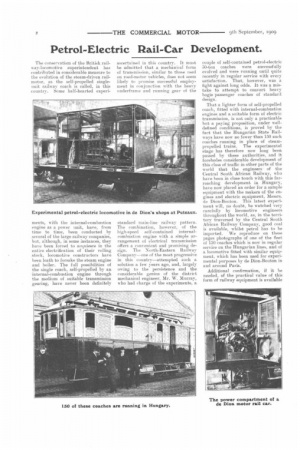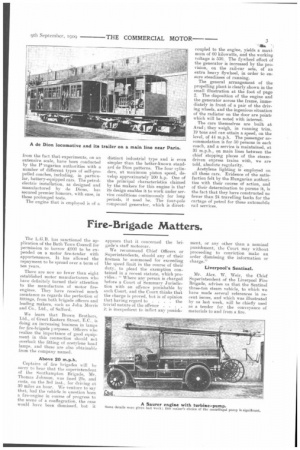Petrol-Electric Rail-Car Development.
Page 2

Page 3

If you've noticed an error in this article please click here to report it so we can fix it.
The conservatism of the British railway-locomotive superintendent has contributed in considerable measure to the evolution of the steam-driven railmotor, as the self-propelled singleunit railway coach is called, in this country. Some half-hearted experi
meats, with the internal-combustion engine as a power unit, have, from time to time, been conducted by several of the large railway companies, but, although, in some instances, they have been forced to acquiesce in the entire electrification of their rolling stock, locomotive constructors have been loath to forsake the steam engine and boiler. The full possibilities of the single coach, self-propelled by an .internal-combustion engine through the medium of suitable transmission .gearing, have never been definitely
ascertained in this country. It must be admitted that a mechanical form of transmission, similar to those used on road-motor vehicles, does not seem likely to promise successful employment in conjunction with the heavy underframe and running gear of the standard main-hue railway pattern. The combination, however, of the high-speed self-contained internalcombustion engine with a simple arrangement of electrical transmission offers a convenient and promising design. The North-Eastern Railway Company—one of the most progressive in this country—attempted such a solution a few years ago, and, largely owing to the persistence and the considerable genius of the district mechanical engineer, Mr. W. Murray, who had charge of the experiments, a couple of self-contained petrol-electric 50-ton coaches were successfully evolved and were running until quite recently in regular service with every satisfaction. That, however, was a fight against long odds. It was a mistake to attempt to convert heavy bogie passenger coaches of standard design.
That a lighter form of self-propelled coach, fitted with internal-combustion engines and a suitable form of electric transmission, is not only a practicable but a paying proposition, under welldefined conditions, is proved by the fact that the Hungarian State Railways have now no fewer than 150 such coaches running in place of steampropelled trains. The experimental stage has therefore now long been passed by these authorities, and it forebodes considerable development of this class of traffic in other parts of the world that the engineers of the Central South African Railway, who have been in close touch with this farreaching development in Hungary, have now placed an order for a sample equipment with the makers of the engines and electric equipment, Messrs. de Dion-Bouton. This latest experiment will, no doubt, be watched very c:t re fully by locomotive engineers throughout the world, as, in the territory traversed by the Central South African Railway Company, good coal is available, whilst petrol has to be imported. We reproduce on those pages photographs of one of the fleet of 150 coaches which is now in regular service on the Hungarian lines, and of a locomotive fitted with similar equipment, which has been used for experimental purposes by de Dion-Bouton in and around Paris.
Additional confirmation, if it be needed, of the practical value of this form of railway equipment is available
from the fact that experiments, on an extensive scale, have been conducted by the P-ingarian authorities with a number of different types of self-propelled coaches, including, in particitbur, battery-equipped cars. The petrolelectric installation, as designed and manufactured by de Diens, has secured premier honours, with ease, in these prolonged tests.
The engine that is employed is of a
distinct industrial type and is even simpler than the better-known standard de Dion patterns. The four cylinders, at maximum piston speed, develop approximately 100 h.p. One of the principal characteristic claimed by the makers for this engine is that its design enables it to work under service conditions continuously for long periods, if need he Tile four-pole compound generator, which is direct
coupled to the engine, yields a maximum of 60 kilowatts, and the working voltage is 550. The flywheel effect of the generator is increased by the provision, on the rail-car sets, of an extra heavy flywheel, in order to ensure steadiness of running.
The general arrangement of the propelling plant is clearly shown in the small illustration at the foot of page 2. The disposition of the engine and the generator across the frame, immediately in front of a pair of the driving wheels, and the ingenious situation of the radiator on the door are points which will be noted with interest.
The cars themselves are built at Arad; they weigh, in running trim, 19 tons and can attain a speed, on the level, of 44 m.p.h. The passenger accommodation is for 50 persons in each coach, and a service is maintained, at 35 m.p.h., on main lines between the chief stopping places of the steamdriven express trains with, we are told, absolute regularity.
Acetylene lighting is employed on all these cars. Evidence of the satisfaction felt by the Hungarian authorities with their course of action, and of their determination to pursue it, is the fact that they have constructed no fewer than 24 travelling tanks for the cartage of petrol for these automobile rail services.
























